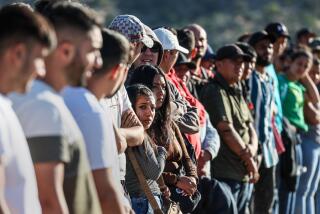An immigrant in limbo between two Americas

- Share via
Maria Gomez stood with the Class of 2011, waiting to climb the stage. The sun was bright on the UCLA campus, her fellow graduates buoyant.
To reach this elite company, she’d worked baby-sitting and housecleaning jobs, scraping up tuition from quarter to quarter. She’d lived on Cup Noodles and granola bars from the food bank when money ran out. She’d spent nights sleeping on the floor of the campus printing room.
At 26, she was getting her master’s in architecture from one of the nation’s top schools. But the triumph felt hollow, her sense of achievement tangled up with bitterness and fear.
From childhood on, she’d straddled paradoxical Americas.
This was the place where your family’s foothold might be dislodged by a single careless word. It was where you had to lie when friends asked why you didn’t have a driver’s license: “An eye condition.” It was where, when your dignified and stoic father thought he saw an immigration-enforcement van, fear made his voice unrecognizable as he screamed: Don’t move!
But there was another America her parents had made her believe in, where the children of immigrants could become professionals, chief executives, pioneers.
The country that made you hide like a criminal and the country that promised to let you stand tall atop your talent — she’d grown up with both, somehow believed in both. But now, about to be pitched into a job market where she could not legally work, she felt dread in her stomach.
Could both places be real?
::
“We’re going to Disneyland.”
It’s 1993. Maria is 8, the exuberant, green-eyed girl beaming from the middle of family photos. Her family is bankrupt, the cattle on their ranch outside Guadalajara dead or dying. She should be excited about the promised vacation. But something’s wrong. She’s supposed to keep the trip a secret.
Mom is in the backyard, sobbing as she feeds the past to a bonfire. Boxes of papers, documents, love letters. Everything that doesn’t fit in the two suitcases the family will bring.
Soon, after they have slipped across the border and found refuge with relatives in Los Angeles, her parents explain: We won’t be returning.
She is told the rules of the new country. Never talk about where you’re from. Be careful who you trust. Obey every law.
Her younger sister, Ana, is enrolled in the wrong grade in their elementary school. Her parents are too nervous to tell school officials. Somebody might ask questions.
If Maria knows invisibility is the first rule of survival, she also understands that being a stand-out student is the only escape from the grinding existence her dad, who dreamed of being a veterinarian, is forced to lead. He waits tables at two restaurants near LAX, swallows his pride when a drunk diner grabs his shirt and screams in his face, doubles up on socks because his feet hurt so much.
Between his morning and evening shifts, he picks his oldest daughter up from school in the family Monte Carlo and explains why he loves America. You can make any life you want. You don’t have to put up with a husband who hurts you, mija, and you don’t have to pay bribes. What counts here are talent and perseverance and the rule of law.
Yet they must live like outlaws, with their application for legal residency stuck in a years-long backlog. Dad assures her that someday the legal papers they ask for in nighttime prayers will come through. “When that day comes,” he says, “you have to be ready.”
Solitude is safe, drawing her refuge. She sits at the kitchen table drafting imaginary houses and filling their rooms with furniture, vases, portraits, a vision of the American Dream rendered in exacting detail. She adds make-believe indexes of scale, to make it look like a real architect’s work. She pores over photos of Europe’s great Gothic cathedrals, fascinated by the elegance of flying buttresses and the weight of the balanced stone.
Maria has the sobriety of the reliable oldest child who knows how much rides on her example. Her parents have two more kids, both American-born, who get used to their big sister chiding them not to squander a single opportunity. They’re a family of seven in a two-bedroom house in Inglewood.
When she tries to escape English as a Second Language classes in the sixth grade and a teacher wonders aloud if she can even read, considering she hasn’t yet mastered English, she feels the need to prove something for all Latinos everywhere.
At Westchester High, she hides in plain sight. Her image pervades her senior yearbook. There she is, the pretty cheerleader with the carefree smile, waving pompoms at Comets games. The jeans-wearing president of the Garden Club, shoveling out a hole. The solemn straight-A student, posing in her academic honors jacket. Only her boyfriend and a couple of friends know her secret.
::
The guidance counselor doesn’t understand.
What do you mean, you have no Social Security number? Did you forget it?
Maria, midway through her senior year, has applications out to four UC schools that she has no idea how she’ll afford. If she’s lucky, she figures, at least she’ll be able to wave around some acceptance letters, to show she was smart enough for the colleges she can’t attend.
Now she sits in the counselor’s office trying to explain an uncomfortable fact.
No, she didn’t lose the number. She doesn’t have one.
The counselor sighs and says, “I can’t do anything for you.” There are no government grants or scholarships for students without papers.
Now she sees it looming, the wall between her and her future, the sight she’s dreaded for years.
Acceptance letters arrive. UC Santa Barbara. UC Irvine. UC Berkeley. UCLA. They all want her.
What now? Well, her parents didn’t raise a quitter. And after all, it’s America. There must be a fissure in the wall.
Berkeley, her first choice, is definitely out, because she could never afford housing. But UCLA? Maybe. She could live at home. And tuition?
To learn about possible funding sources, she volunteers at her high school’s college-planning office. She finds a sympathetic counselor who gives her a grant and directs her to a series of small, private scholarships. She takes odd jobs as a loan processor, dance studio receptionist, baby sitter.
And so she becomes the first in her family to attend college. She’s on the bus five hours a day. She interns at a downtown L.A. architecture firm. She’s up past midnight in the backyard, wielding a table saw over her models.
Everywhere, there are reminders of her precarious status. The chill in her spine when she sees a cop. The excuses she gives when friends invite her to movies that require ID. The talk-radio drumbeat about illegal immigrants stealing jobs. But she begins to see she’s not alone — there are other UCLA students without papers, struggling like her, and they talk about the need to come forward and assert themselves.
Then her mother — her closest confidante and biggest supporter, who always told her she could do anything — starts to wheeze. Doctors think it’s asthma, but it doesn’t go away, and finally they diagnose pulmonary fibrosis. She lives long enough to see Maria graduate with her bachelor’s degree.
::
“You’re an illegal?”
It’s her final year at UCLA’s School of Art and Architecture, and she’s explaining to a professor why she will miss an upcoming review of her classwork. She will be campaigning for passage of the California Dream Act, meant to make financial aid available to undocumented students like herself.
“You’re an illegal?” the professor says again, guilelessly, but loud enough for others to hear.
By now she’s grown vocal, an organizer of rallies and lobbying campaigns, and her schoolwork has suffered. Like hundreds of others who were brought to the States illegally as children, she does something her parents could never do — announce her presence, calculating that there is more to gain than lose.
But her identities remain compartmentalized. She keeps her secret from her grad-school peers, many of them white, affluent, well-connected, her rivals in a climate of cutthroat competition in which she feels forever one step behind.
Sometimes, it’s possible to forget she’s not one of them. Like the time the senior class books flights to study the architectural marvels of Europe. Finally she’ll stand inside Notre Dame, Sacre Coeur, Versailles, Sagrada Familia.
“I had forgotten I couldn’t leave the country,” she says.
After the professor’s outburst, it’s impossible to keep the truth from her classmates. To her surprise, no one maligns her. One even offers to sign a petition.
When they graduate last June, she’s indistinguishable from her classmates in their ironed gowns and mortarboard caps. But the others are sending out resumes. They’ll be getting jobs as engineers, project managers, museum assistants.
For her, it’s the culmination of a dream, and if her mom were alive she’d be bawling her eyes out, and though her quiet, unexpressive father doesn’t come out and say it, she sees him bursting with pride. At the same time, the day marks the start of a limbo whose end she cannot see.
::
She sits at a Starbucks near her home, not far from LAX, with her laptop open in front of her. She’s just been laid off from a job at a nonprofit. She’s assembling her portfolio, preparing to compete in a field hard hit by the economy.
Planes lift off and set down behind her. Being so close to the airport, gateway to the world, is a cruel irony. She can’t go to any of those places.
“I want to be able to work. I want to be able to give back to the country,” she says. “Most people are like, ‘Are you practicing architecture now?’ I’m kind of living in denial.”
One day, nearly a year after her graduation, a call comes from nowhere. It’s a Mexican American builder who met her last year at the Mexican Consulate in Los Angeles, where she spoke about her life. He’s building a small medical office in Chino Hills. Would she draft the blueprints? She’s done schematic designs, but never the nitty-gritty detail work that shows where the wiring and plumbing goes. She’ll have to learn quick.
“You know this is my first job?” she says.
He does, and he wants to help. She’ll work for almost nothing. She just wants a chance. It might be the start of a business relationship. It might be her chance to move out of her dad’s garage.
“The more you tell your story, the more you put yourself out there,” she says excitedly after the conversation. “If I’d stayed home and cried my heart out over my situation, this wouldn’t have happened.”
Yet because she has no license and no insurance, she must enlist the help of an established architect, a former professor, whose quoted price startles her: $25,000.
She relays it to the contractor, who says it’s twice as much as he wants to pay, and who says he’ll keep her posted.
When the phone doesn’t ring, she says, “I’m not completely heartbroken.” She’s already looking for other leads. Because she’s been here before, and she knows what an American does.
christopher.goffard@latimes.com
More to Read
Sign up for Essential California
The most important California stories and recommendations in your inbox every morning.
You may occasionally receive promotional content from the Los Angeles Times.











